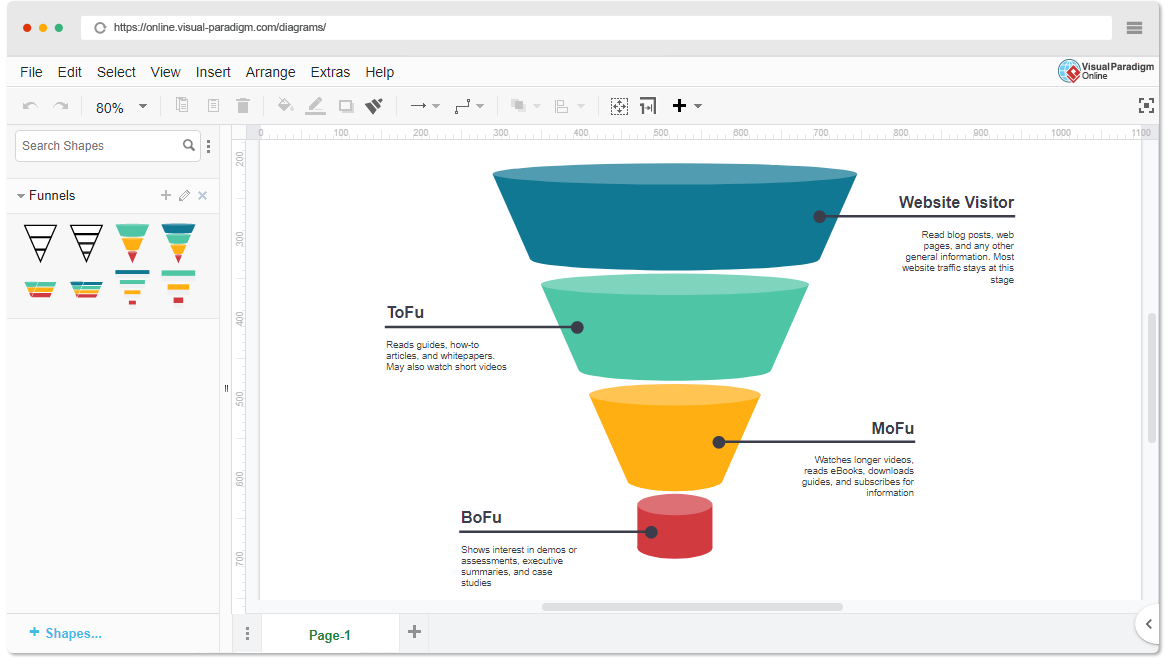Comprehensive Guide to ToFu, MoFu, and BoFu Sales Funnel Strategy
Introduction
In the world of sales and marketing, successfully converting leads into loyal customers requires a well-structured approach. ToFu, MoFu, and BoFu are key concepts within the sales funnel strategy that help businesses tailor their marketing efforts to different stages of the customer’s purchasing journey. This guide will provide you with a comprehensive understanding of ToFu, MoFu, and BoFu, including their purposes, key concepts, and essential elements, accompanied by examples created using Visual Paradigm Online templates.

1. Introduction to ToFu, MoFu, and BoFu
1.1 What Are ToFu, MoFu, and BoFu?
ToFu, MoFu, and BoFu are a set of sales and marketing strategies designed to align with different stages of the sales funnel. The sales funnel represents the journey that potential customers take, starting with a wide pool of leads at the top and progressively narrowing down to successful conversions at the bottom. The abbreviations stand for:
- ToFu (Top-of-Funnel): This stage focuses on casting a wide net to attract potential leads. It is analogous to the appetizer in a meal, where you provide valuable content without pressure to address initial needs, questions, or problems.
- MoFu (Middle-of-Funnel): MoFu corresponds to the main course in a meal. In this stage, marketers aim to position their company as the ideal solution provider for the customer’s specific needs. It involves more targeted content and offers.
- BoFu (Bottom-of-Funnel): The BoFu stage is akin to dessert, where you aim to close the sale. Here, the focus is on converting leads into customers. It often involves direct person-to-person contact and highly persuasive content.

2. Purpose of ToFu, MoFu, and BoFu
2.1 The Purpose of ToFu
The primary purpose of ToFu is to generate a high volume of leads and create awareness about your products or services. At this stage, you provide valuable information that addresses the initial needs or questions of potential customers without overwhelming them.
2.2 The Purpose of MoFu
MoFu aims to nurture and educate leads who have shown interest in your offerings during the ToFu stage. It’s about positioning your company as the best choice for addressing their specific needs. MoFu involves building trust and credibility.
2.3 The Purpose of BoFu
BoFu is the final push to convert leads into paying customers. Here, you aim to close the sale by demonstrating the unique value your product or service offers. It often involves more personalized interactions and persuasive content.
3. Key Concepts and Elements
3.1 Key Concepts
- Lead Nurturing: At each stage, the goal is to nurture leads, keeping them engaged without being overly pushy or annoying.
- Content Relevance: Providing relevant content that addresses the needs and questions of leads at each stage is crucial.
- Efficiency: Many companies use marketing automation to streamline lead nurturing campaigns and make them more efficient.
3.2 Essential Elements
ToFu
- Content Types: Blogs, white papers, eBooks
- Objective: Awareness and engagement
- Communication: Non-intrusive, informative
MoFu
- Content Types: Podcasts, comparison charts, webinars
- Objective: Building trust and credibility
- Communication: More targeted and personalized
BoFu
- Content Types: Case studies, trials, live demos, consultations
- Objective: Conversion and closing the sale
- Communication: Personalized, persuasive, and direct
4. Learn by Examples with Visual Paradigm Online
Now, let’s explore examples of ToFu, MoFu, and BoFu strategies using pre-made templates available in Visual Paradigm Online, a versatile diagramming tool
Conclusion
ToFu, MoFu, and BoFu are essential components of a successful sales and marketing strategy. Understanding their purposes, key concepts, and elements will enable you to tailor your approach to different stages of the sales funnel, ultimately increasing your chances of converting leads into loyal customers. Visual Paradigm Online offers valuable templates to assist you in visualizing and implementing these strategies effectively.

